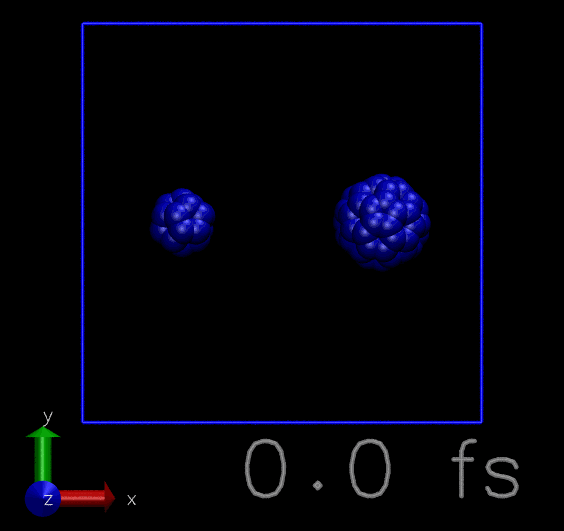- 2016-10-21 16:56:11
Sobereva曾给过一个tcl脚本, 用于解决VMD不能读入GROMACS轨迹速度信息的问题, 具体参考 使VMD读入Gromacs产生的trr轨迹中速度信息的方法. 最近我需要用到VMD的这个功能, 就稍微看了下tcl的语法, 在原代码的基础上改进了一点, 使其使用更简单. 同时结合Sobereva的另一段代码 使VMD播放轨迹时同步显示帧号, 在播放轨迹的同时显示出模拟时间.
下面模拟的是C20和C60分子的相撞过程, 播放轨迹时对每个原子根据速度大小进行着色.

使用方法
- 运行MD前将
grompp.mdp文件中trr与xtc的输出频率设为相同 - 使用
gmx traj -f traj.trr -ov抽取traj.trr轨迹文件中的速度, 默认存为veloc.xvg - 使用VMD加载初始的
conf.gro文件和traj.xtc轨迹文件(直接使用trr文件可能更简单, 但速度稍慢). 也可直接使用命令vmd conf.gro traj.xtc - 将
vt.tcl脚本复制到轨迹文件所在目录下 - VMD命令行窗口中执行
source vt.tcl使脚本生效 - VMD命令行窗口中执行
loadveloc即可加载veloc.xvg文件中的速度. 如果速度文件的名称不是veloc.xvg, 则使用loadveloc 速度文件名即可 - 如果播放轨迹时需要显示时间, 可在VMD命令行窗口中执行
showtime. 执行showtime off则关闭时间显示. 默认的时间间隔为0.5 fs, 起始时间为0, 如需更改, 可使用showtime on 时间间隔 起始时间 - 播放轨迹时对每个原子根据速度大小进行着色, 可通过
Graphics | Representations... | Coloring Method | trajectory | Velocity. 如需根据某一方向速度大小着色, 可使用User(x方向),User2(y方向),User3(z方向) - 更改颜色方案, 可使用
Graphics | Colors... | Color Scale | Method.
几点说明
-
这种基于tcl的方法可行, 但需要编写tcl脚本. 如果你不喜欢tcl脚本的话, 至少还有两个变通的替代方案: 1. 可以将gromacs的轨迹文件转换为lammps的轨迹文件, 因为vmd支持读取lammps轨迹文件中的速度. 2. 将速度写到pdb文件中的温度因子或电荷列中, 再根据相应的项进行着色.
gmx traj的-cv选项一定程度上可以完成这点, 但效率太低. -
对原子根据其速度进行着色并不总是最好的方法, 更好的方法是根据动能或温度进行着色. 一则原子类型不同时, 质量小的原子速度会相对较大, 二则人们对原子速度大小没有多少直观感觉, 添加颜色标尺时不易把握. 如果使用相对动能或温度, 就更加直观, 也更容易把握了. 只要对脚本稍加修改就可以达到这个目的.
-
对于温度或速度这种物理量而言, 使用分散颜色方案是最好的, VMD中接近这种颜色方案的是
BWR, 但仍有不少差距. 如果想使用自定义的颜色方案, 除了自己写tcl代码以外, 目前我不知道有没有简单的办法. 有关发散颜色方案的信息可参考我的另外两篇博文: 数据展示:请选择好的颜色映射方案, 几种颜色映射方案的解析式. -
tcl中的
trace可以使用回调函数(callback)进行变量跟踪, 使用trace时回调函数必须带有参数, 否则执行有问题. 此外, 新版本tcl中trace的语法有所改变, 上面脚本中的使用方式以后会废弃, 建议大家使用时尽量使用新版本的语法. 具体可参看下面的资料: VMD手册: Tcl callbacks, tcl手册: trace.
vt.tcl脚本
| vt.tcl | |
|---|---|
1 2 3 4 5 6 7 8 9 10 11 12 13 14 15 16 17 18 19 20 21 22 23 24 25 26 27 28 29 30 31 32 33 34 35 36 37 38 39 40 41 42 43 44 45 46 47 48 49 50 51 52 53 54 | proc showtime { {opt on} {dtin 0.5} {t0in 0} } {
global vmd_frame; global dt; global t0
set dt $dtin
set t0 $t0in
if {$opt==on} {
trace variable vmd_frame([molinfo top]) w traceframe
} elseif {$opt==off} {
draw delete all
trace vdelete vmd_frame([molinfo top]) w traceframe
}
}
proc traceframe {name elem ops} {
global vmd_frame; global dt; global t0
draw delete all
draw color white
set time [format "%6.1f fs" [expr ($vmd_frame([molinfo top]) * $dt) + $t0]]
draw text {0 -5 -5} "$time" size 4 thickness 4
}
proc loadveloc { {Fxvg veloc.xvg} } {
set Mol [atomselect top all]
set Natm [$Mol num]
set Nfrm [molinfo top get numframes]
set Fxvg [open $Fxvg r]
gets $Fxvg txt
while {[string match {[\#@]*} $txt]} {
gets $Fxvg txt
}
set txt [split $txt \t]
for {set i 1} {$i<$Nfrm} {incr i} {
$Mol frame $i
set Vx {}; set Vy {}; set Vz {}
for {set j 0} {$j<$Natm} {incr j} {
lappend Vx [ lindex $txt [expr 3*$j+1] ]
lappend Vy [ lindex $txt [expr 3*$j+2] ]
lappend Vz [ lindex $txt [expr 3*$j+3] ]
}
$Mol set vx $Vx
$Mol set vy $Vy
$Mol set vz $Vz
$Mol set user $Vx
$Mol set user2 $Vy
$Mol set user3 $Vz
gets $Fxvg txt
set txt [split $txt \t]
}
close $Fxvg
}
|
评论
- 2016-10-22 10:21:14
李正这两个分子相撞是怎么实现的啊? -
2016-10-22 13:59:03
Jerkwin把两个分子的速度设为方向相反, 运行NVE模拟即可. - 2016-11-07 11:43:09
粥四文gmx 不是内部命令? -
2016-11-08 08:21:30
Jerkwin按你安装好的gmx来写, 或许是gmx_mpi之类的 - 2016-11-08 11:06:11
粥四文”将vt.tcl脚本复制到轨迹文件所在目录下“,怎么弄?tcl文件,是下载一个tcl.pro软件编写吗?我是个初学者,不太理解。麻烦您了。 - 2016-11-08 21:46:11
Jerkwin新建一个文本文档, 将下面的脚本复制粘贴进去, 保存为vt.tcl, 就可以了.
